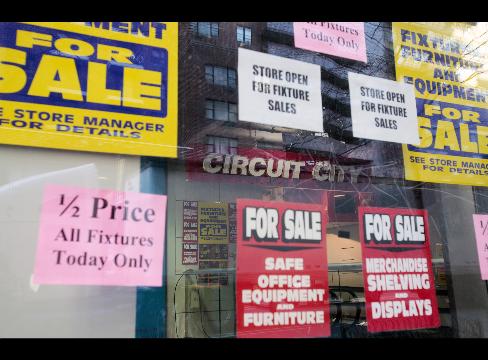YouTube Added: 03.05.2013
Retailers
16 Signs That The Middle Class Is Running Out Of Money
– Consumer Spending Drought: 16 Signs That The Middle Class Is Running Out Of Money (Economic Collapse, Feb 28, 2013):
Is “discretionary income” rapidly becoming a thing of the past for most American families? Right now, there are a lot of signs that we are on the verge of a nightmarish consumer spending drought. Incomes are down, taxes are up, many large retail chains are deeply struggling because of the lack of customers, and at this point nearly a quarter of all Americans have more credit card debt than money in the bank. Considering the fact that consumer spending is such a large percentage of the U.S. economy, that is very bad news. How will we ever have a sustained economic recovery if consumers don’t have much money to spend? Well, the truth is that we aren’t ever going to have a sustained economic recovery. In fact, this debt-fueled bubble of false hope that we are experiencing right now is as good as things are going to get. Things are going to go downhill from here, and if you think that consumer spending is bad now, just wait until you see what happens over the next several years.
Read more16 Signs That The Middle Class Is Running Out Of Money
Retailers Blame Drop In Black Friday Sales On Black Thursday
– Retailers Blame Drop In Black Friday Sales On Black Thursday (ZeroHedge, Nov 25, 2012):
With all bad news on the tape now having a suitable “explanation”, be it a prior president, a tropical storm, the weather being too hot, the weather being too cold, the weather being just right, but never, ever someone actually taking blame for the fact that life is what happens when corporate CEOs (and sovereign presidents) are busy making “priced to perfection” plans. So it is with what is now a confirmed flop of a Black Friday, which according to ShopperTrak saw sales drop by nearly 2% to $11.2 from 2011, which in turn was a 6.6% gain over 2010 (and would be revised to far lower once all the refunds and exchanges to cash took place in the two weeks later). This occurred despite a 3.5% increase in retail foot traffic to 307.7 million store visits. The nominal drop in retail sales also occurred despite a nearly 1% increase in the total US population over last Thanksgiving, and a 2% Y/Y inflation. But fear not: the ad hoc excuse for this “surprising” loss in purchasing power is already handy: it is all Black Thursday’s fault, or the latest idiotic attempt by retailers to cannibalize their own future sales by diluting the exclusivity of Black Friday, and which will force all retailers to follow the sovereigns in a race to the bottom, as soon every day will be the equivalent of Black Friday. But at least retailers have another 364 years worth of excuses for the conceivable future to excuse any and all store weakness. Next year: it’s all Black Wednesday’s fault.
From Bloomberg:
Read moreRetailers Blame Drop In Black Friday Sales On Black Thursday
Mystery Of July Retail Sales ‘Beat’ Solved: It Is All In The ‘Seasonal Adjustment’ … And That Is How Data Is Fudged
– Mystery Of July Retail Sales “Beat” Solved: It Is All In The “Seasonal Adjustment” (ZeroHedge, Aug 14, 2012):
The July retail sales beat came as a surprise to many: an 0.8% increase (full series here) at a time when the data was supposed to grow at less than half this would surely be indicative of a potential turnaround in the US economy. Then we decided to do a quick spot check if maybe the Census Bureau had not adopted one of the BLS’ worst habits: fudging seasonal adjustment factors. The reason for this is because we happened to notice that Not Seasonally Adjusted (full series here) retail sales data in July actually declined by 0.9% from $405.8 to $402 billion. Of course, if the Census Bureau was using a consistent, or at least remotely comparable July seasonal adjustment factor as it has in the past, this would make sense and we would move on. So we decided to look at what the July seasonal adjustment variance over the past decade has been. What we found would have shocked us if indeed this is not precisely what we expected: with the July seasonal adjustment factor routinely subtracting a substantial amount from the NSA number, averaging at -$5.2 billion, in 2012, for the first time this decade, the seasonal adjustment not only did not subtract, but in fact added “value” to the NSA number, resulting in a seasonally adjusted number that was $1.9 billion higher than the NSA number at $403.9 billion.
So what would have happened if instead of arbitrarily deciding to add a seasonal contribution for the first time in a decade, the Census Bureau had used the last decade average factor of $5.2 billion (not adjusted for inflation, so the end number would be far greater)? Instead of rising by 0.8% Seasonally Adjusted retail sales would have declined from $400.7 billion to $395.5 billion, or a 1.3% decline.
And that is how data is fudged.
Those curious what the model behind this now glaringly obvious seasonal adjustment fudge is, read on (source):
Sears Holdings Corp. To Close At Least 100 Sears, Kmart Stores
– Company to close at least 100 Sears, Kmart stores (AP, Dec 27, 2011):
NEW YORK — After a disastrous holiday shopping season, the parent company of Sears and Kmart will close at least 100 stores to raise cash — a move that sparked speculation about whether the 125-year-old retailer can avoid a death spiral fed by declining sales and deteriorating stores.
Sears Holdings Corp., a pillar of American retailing that famously began with a mail-order catalog in the 1880s, declared Tuesday that it would no longer prop up “marginally performing” locations. The company pledged to refocus its efforts on stores that make money.
Sears’ stock quickly plunged, dropping 27 percent.
Read moreSears Holdings Corp. To Close At Least 100 Sears, Kmart Stores
And Now Clothing Inflation: Prices to Rise 10% Starting in Spring
And clothing prices will continue to rise:
– Cotton Prices Jump, Continue To Skyrocket, Mills Panic
– Cotton Prices Rise To A 140-Year Record High
Clothing Prices to Rise 10% Starting in Spring
The era of falling clothing prices is ending. Clothing prices have dropped for a decade as tame inflation and cheap overseas labor helped hold down costs.
Retailers and clothing makers cut frills and experimented with fabric blends to cut prices during the recession. But as the world economy recovers and demand for goods rises, a surge in labor and raw materials costs is squeezing retailers and manufacturers who have run out of ways to pare costs.
Cotton has more than doubled in price over the past year, hitting all-time highs. The price of other synthetic fabrics has jumped roughly 50 percent as demand for alternatives and blends has risen.
Clothing prices are expected to rise about 10 percent in coming months, with the biggest increases coming in the second half of the year, said Burt Flickinger III president of Strategic Resource Group.
Read moreAnd Now Clothing Inflation: Prices to Rise 10% Starting in Spring
Total Desperation: Retailers Push ‘Christmas in July’
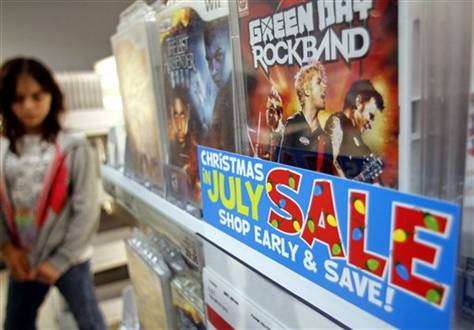
Toys R Us is promoting its summertime discounts more heavily than last year with deals of the day and free shipping through Saturday.
NEW YORK — Santa in the summer?
Retailers are pumping still more energy this year into trying to get shoppers to loosen their purse strings early for Christmas with sparkly ornaments, holiday music and special prices. In July.
Target Corp. is entering the game for the first time, with a one-day online sale starting Friday on 500 items from clothing to Blu-ray disc players that’s modeled after sales typically held Thanksgiving weekend. And Sears and Toys R Us are dramatically promoting “Christmas in July” online and in the stores based on the success they saw in last year’s efforts.
“We really wanted to create that sense of excitement, that sense of urgency,” said Target spokeswoman Molly Hanus.
Read moreTotal Desperation: Retailers Push ‘Christmas in July’
With The US Still Trapped in Depression, This Really Is Starting to Feel Like 1932
This is the Greatest Depression.
The US workforce shrank by 652,000 in June, one of the sharpest contractions ever. The rate of hourly earnings fell 0.1pc. Wages are flirting with deflation.
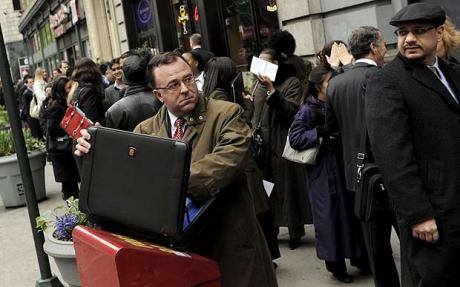
People queue for a job fair in New York. The share of the US working-age population with jobs in June fell from 58.7pc to 58.5pc. The ratio was 63pc three years ago. Photo: EPA
“The economy is still in the gravitational pull of the Great Recession,” said Robert Reich, former US labour secretary. “All the booster rockets for getting us beyond it are failing.”
“Home sales are down. Retail sales are down. Factory orders in May suffered their biggest tumble since March of last year. So what are we doing about it? Less than nothing,” he said.
California is tightening faster than Greece. State workers have seen a 14pc fall in earnings this year due to forced furloughs. Governor Arnold Schwarzenegger is cutting pay for 200,000 state workers to the minimum wage of $7.25 an hour to cover his $19bn (£15bn) deficit.
Can Illinois be far behind? The state has a deficit of $12bn and is $5bn in arrears to schools, nursing homes, child care centres, and prisons. “It is getting worse every single day,” said state comptroller Daniel Hynes. “We are not paying bills for absolutely essential services. That is obscene.”
Roughly a million Americans have dropped out of the jobs market altogether over the past two months. That is the only reason why the headline unemployment rate is not exploding to a post-war high.
Let us be honest. The US is still trapped in depression a full 18 months into zero interest rates, quantitative easing (QE), and fiscal stimulus that has pushed the budget deficit above 10pc of GDP.
The share of the US working-age population with jobs in June actually fell from 58.7pc to 58.5pc. This is the real stress indicator. The ratio was 63pc three years ago. Eight million jobs have been lost.
The average time needed to find a job has risen to a record 35.2 weeks. Nothing like this has been seen before in the post-war era. Jeff Weninger, of Harris Private Bank, said this compares with a peak of 21.2 weeks in the Volcker recession of the early 1980s.
“Legions of individuals have been left with stale skills, and little prospect of finding meaningful work, and benefits that are being exhausted. By our math the crop of people who are unemployed but not receiving a check amounts to 9.2m.”
Republicans on Capitol Hill are filibustering a bill to extend the dole for up to 1.2m jobless facing an imminent cut-off. Dean Heller from Vermont called them “hobos”. This really is starting to feel like 1932.
Washington’s fiscal stimulus is draining away. It peaked in the first quarter, yet even then the economy eked out a growth rate of just 2.7pc. This compares with 5.1pc, 9.3pc, 8.1pc and 8.5pc in the four quarters coming off recession in the early 1980s.
The housing market is already crumbling as government props are pulled away. The expiry of homebuyers’ tax credit led to a 30pc fall in the number of buyers signing contracts in May. “It is cataclysmic,” said David Bloom from HSBC.
Read moreWith The US Still Trapped in Depression, This Really Is Starting to Feel Like 1932
Sam’s Club cuts 11,200 jobs, 10 percent of workforce
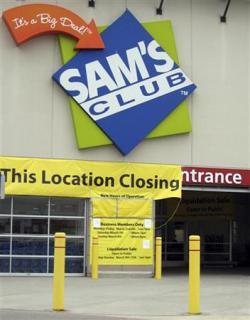 |
SAN FRANCISCO (Reuters) – Sam’s Club, the warehouse club division of Wal-Mart Stores Inc is cutting roughly 11,200 jobs, or about 10 percent of its workforce, as it outsources in-store product demonstrations and eliminates positions used to recruit new business members.
Sam’s Club Chief Executive Officer Brian Cornell said on Sunday that the retailer would outline charges associated with the job cuts in February, when it releases fourth-quarter results. He said he did not expect any “material impact” on its financial results.
“We look at this as an investment in the in-club experience,” Cornell said in an interview. “This is not a cost-cutting move for us in the short term. We really hope it will be cost neutral for our operation. It’s an investment in building loyalty, enhancing the member experience and driving future growth.”
Read moreSam’s Club cuts 11,200 jobs, 10 percent of workforce
H&M and Wal-Mart Destroy and Trash New, Unsold Clothes

Cynthia Magnus holds up unworn, destroyed clothing she found in the garbage. Photo by Suzanne DeChillo/New York Times
This week the New York Times reported a disheartening story about two of the largest retail chains. You see, instead of taking unsold items to sample sales or donating them to people in need, H&M and Wal-Mart have been throwing them out in giant trash bags. And in the case that someone may stumble on these bags and try to keep or re-sell the items, these companies have gone ahead and slashed up garments, cut off the sleeves of coats, and sliced holes in shoes so they are unwearable.
This unsettling discovery was made by graduate student Cynthia Magnus outside the back entrance of H&M on 35th street in New York City. Just a few doors down, she also found hundreds of Wal-Mart tagged items with holes made in them that were dumped by a contractor. On December 7, she spotted 20 bags of clothing outside of H&M including, “gloves with the fingers cut off, warm socks, cute patent leather Mary Jane school shoes, maybe for fourth graders, with the instep cut up with a scissor, men’s jackets, slashed across the body and the arms. The puffy fiber fill was coming out in big white cotton balls.”
The New York Times points out that one-third of the city’s population is poor, which makes this behavior not only wasteful and sad, but downright irresponsible. Wal-Mart spokeswoman, Melissa Hill, acted surprised that these items were found, claiming they typically donate all unworn merchandise to charity. When reporters went around the corner from H&M to a collections drop-off for charity organization New York Cares, spokesperson Colleen Farrell said, “We’d be glad to take unworn coats, and companies often send them to us.”
Read moreH&M and Wal-Mart Destroy and Trash New, Unsold Clothes
What Recovery? US Consumers Getting ‘Dramatically Worse,’ Howard Davidowitz Says
According to the National Retail Federation, retail sales over the Thanksgiving holiday weekend were $41.2 billion, up slightly from a year ago, while about 195 million consumers shopped, up from 172 million last year.
Meanwhile, Coremetrics says the average online shopper spent 35% more on Black Friday vs. a year ago, while robust sales were predicted for Cyber Monday.
Against that backdrop, you might expect Howard Davidowitz of Davidowitz & Associates to backtrack from some of the bearishness he’s professed on Tech Ticker (and elsewhere) in the past year. But you’d be wrong.
“The consumer is in worse shape since I was here last” in August, Davidowitz says, citing the following:
- Unemployment has exploded: “We’ve lost a ton of jobs since I was here last,” Davidowitz says, noting the “real” unemployment rate is 17.5%. “That’s an astounding number.”
- Housing continues to sink: “The consumers’ biggest asset is down trillions” in value while “foreclosures are exploding” and a huge percentage have negative equity — 23% according to CoreLogic.
- Record numbers of consumer bankruptcies: The American consumer has “never been further behind…never defaulted more” on mortgages, student loans, auto loans, and credit card bills, he says.
- Poverty on the Rise: One in eight Americans and one in four children are receiving food stamps, as The NYT reported this weekend.
Read moreWhat Recovery? US Consumers Getting ‘Dramatically Worse,’ Howard Davidowitz Says
The US is in a ‘Death Spiral’ and ‘in the Tank Forever’, says Davidowitz
Rather than summarize, let me just highlight some of his best one-liners:
On retail:
- “The retail business is terrible… It’s almost all negative.”
- “We’re going to close hundreds of thousands of stores.”
On the consumer:
- “They’re still over leveraged, they’re losing jobs, their credit has been cut back.”
On America:
- “We are in the tank forever. As a country we are out of control, we’re in a death spiral.”
On the stock market:
- “We’re in terrible shape. That’s what the fundamentals tell me. I can’t explain the stock market.”
Read moreThe US is in a ‘Death Spiral’ and ‘in the Tank Forever’, says Davidowitz
German retail giant Arcandor goes bust: 43,000 jobs at risk
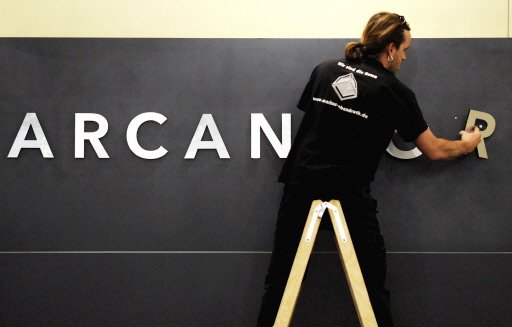
Retail and tourism giant Arcandor has filed for bankruptcy
BERLIN (AFP) — Retail and tourism giant Arcandor said on Tuesday it had filed for bankruptcy with the likely loss of around 43,000 jobs in Germany, after Berlin dismissed its request for emergency state aid.
“Arcandor AG today filed with the Essen District Court to open insolvency proceedings due to threatening illiquidity,” the statement said.
Related article: Arcandor Files for Insolvency on State Aid Rejection (Bloomberg)
Travel agency Thomas Cook, in which Arcandor holds a 52-percent stake, “will remain unaffected by the insolvency proceedings,” the statement added.
The group, which employs 70,000 people in Europe, two-thirds of whom work in Germany, said its department store chain Karstadt, as well as mail-order company Quelle, would also be affected by the insolvency.
On Monday, Berlin rejected the company’s request for 650 million euros (902 million dollars) in state loan guarantees and 437 million euros in emergency loans but gave the firm one last chance to submit an improved bid.
Read moreGerman retail giant Arcandor goes bust: 43,000 jobs at risk
ON THE EDGE with Max Keiser: The Worst Is Yet to Come (05/22/09)
This bear market rally is short lived. The Greatest Depression is here.
This is a MUST-SEE.
Insiders are dumping their stocks at an alarming rate.
Related article:
“The Worst Is Yet to Come”: “If the consumer isn’t petrified, he or she is a damn fool.”
1 of 2:
Source: YouTube
2 of 2:
Source: YouTube
Malls shedding stores at record pace
This will be much bigger than the subprime mortgage crisis:
– Gerald Celente: The Collapse of 2009; The Greatest Depression
– Mass Retail Closings: About 220,000 stores may close this year
Vacancy rates at strip malls, neighborhood markets and community centers accelerate as retailers confront spending slump, industry report says.
NEW YORK (CNNMoney.com) — Strip malls, neighborhood centers and regional malls are losing stores at the fastest pace in at least a decade, as a spending slump forces retailers to trim down to stay afloat, according to a real estate industry report.
The consequence for consumers: Fewer stores to shop and less product choice.
In just the first quarter of 2009, retail tenants at these centers have vacated 8.7 million square feet of commercial space, according to the latest report from New York-based real estate research firm Reis.
That number exceeds the 8.6 million square feet of retail space that was vacated in all of 2008.
Reis’ report shows that store vacancy rates at malls rose 9.5% in the first quarter, outpacing the 8.9% vacancy rate registered in all of 2008, and marking the largest single-quarter jump in vacancies since Reis began publishing quarterly figures in 1999.
“These record numbers are symptomatic of the pervasive weakness that we’re seeing across economic sectors,” said Victor Calanog, director of research with Reis.
“Consumers are worried about their asset bases and they aren’t buying things,” he said. “Their home values and retirement accounts are still reeling, and consumers remain concerned about future income as job losses accelerate.”
Mass Retail Closings: About 220,000 stores may close this year
About 220,000 stores may close this year in America, says our guest, retail consultant Howard Davidowitz of Davidowitz & Associates.
As more Americans save and spend less, it’s clear there’s too much retail space. Just visit Web site deadmalls.com and track retail’s growing body count. And luxury retailers? They’re on “life support,” Davidowitz says.
Among the brandname stores Davidowitz says are in trouble:
- Nordstrom
- Neiman Marcus
- Tiffany
- Jeweler Zale Corp.
- Saks
- J.C. Penney
- Sears
Don’t miss: Gerald Celente: The Collapse of 2009; The Greatest Depression
Read moreMass Retail Closings: About 220,000 stores may close this year
Gerald Celente: The Collapse of 2009; The Greatest Depression
If Nostradamus were alive today, he’d have a hard time keeping up with Gerald Celente.
– New York Post
When CNN wants to know about the Top Trends, we ask Gerald Celente.
– CNN Headline News
There’s not a better trend forecaster than Gerald Celente. The man knows what he’s talking about. – CNBC
Those who take their predictions seriously … consider the Trends Research Institute.
– The Wall Street Journal
A network of 25 experts whose range of specialties would rival many university faculties.
– The Economist
1 of 4:
17. Januar 2009
Source: YouTube
Read moreGerald Celente: The Collapse of 2009; The Greatest Depression
Company selling food past its best-before date thrives in economic crisis
A company which specialises in selling food past its best-before date has seen a 10-fold rise in sales as shoppers hunt for bargains in the economic crisis.
Approved Food, an online retailer, has witnessed such a large increase in trade that it has to shut down its website for two days a month to clear order backlogs.
The Sheffield-based firm’s founder, Dan Cluderay, said: “We have seen a significant rise in interest, probably due to the credit crunch and our low prices.”
Approved Food sells 750g jars of Nutella chocolate and hazlenut spread with a best-before date of January 4 for £1. The same product in Tesco sells for £2.55.
Bargain hunters can also pick up 400g tubes of Marmite Big Squeeze, best before February, for £2, while Tesco charges £2.47 for a jar half that size.
Mr Cluderay said the rise in sales was most pronounced since last September’s banking crisis.
While products past their best-before date might be past their prime, they are still safe to eat, the Food Standards Agency said.
Read moreCompany selling food past its best-before date thrives in economic crisis
440 retailers to go bust in first four months of the year, analysts predict
Nearly 26 retailers will collapse every week in the first four months of the year, a leading retail analyst has predicted.

Morgan, the High Street fashion chain, has collapsed into administration Photo: AFP/GETTY IMAGES
The forecast comes as Morgan, the French fashion chain, becomes the latest victim of the crisis on the high street, collapsing into administration. It joins a lengthening list of shop groups to have failed this week alone, including clothing store USC, Adams childrenswear group and Olan Mills the photography studio.
Experian, a data company which analyses the sector, predicts that a total of 440 retail businesses will go into administration in the first four months of 2009, equating to nearly 26 every week. This would be the worst period for shopkeepers since the depths of the winter of discontent thirty years ago.
Very few shops will escape completely unscathed, Experian predicts, with major chains – with branches on most high streets – as well as small, individual retailers all being hit by the severe consumer downturn.
Read more440 retailers to go bust in first four months of the year, analysts predict
Retailers may close 73,000 stores; Wave of store closings, bankruptcies and takeovers
For sale signs sit on the window of a former Circuit City store in New York, on Dec. 29, 2008. Photographer: Jeremy Bales/Bloomberg News
Dec. 29 (Bloomberg) — U.S. retailers face a wave of store closings, bankruptcies and takeovers starting next month as holiday sales are shaping up to be the worst in 40 years.
Retailers may close 73,000 stores in the first half of 2009, according to the International Council of Shopping Centers. Talbots Inc. and Sears Holdings Corp. are among chains shuttering underperforming locations.
More than a dozen retailers, including Circuit City Stores Inc., Linens ‘n Things Inc., Sharper Image Corp. and Steve & Barry’s LLC, have sought bankruptcy protection this year as the credit squeeze and recession drained sales. Investors will start seeing a wide variety of chains seeking bankruptcy protection in February when they file financial reports, said Burt Flickinger.
“You’ll see department stores, specialty stores, discount stores, grocery stores, drugstores, major chains either multi- regionally or nationally go out,” Flickinger, managing director of Strategic Resource Group, a retail-industry consulting firm in New York, said today in a Bloomberg Radio interview. “There are a number that are real causes for concern.”
Read moreRetailers may close 73,000 stores; Wave of store closings, bankruptcies and takeovers
25% of Retailers May Go Bankrupt

Retailing has always been a tough business. Now it’s a brutal business. Some observers now predict that more than 25% of retailers may go bust in the the next two years.
A great WSJ quote driving home how this truly is retail’s Schumpeterian moment:
Analysts estimate that from about 10% to 26% of all retailers are in financial distress and in danger of filing for Chapter 11. AlixPartners LLP, a Michigan-based turnaround consulting firm, estimates that 25.8% of 182 large retailers it tracks are at significant risk of filing for bankruptcy or facing financial distress in 2009 or 2010. In the previous two years, the firm had estimated 4% to 7% of retailers then tracked were at a high risk for filing.



